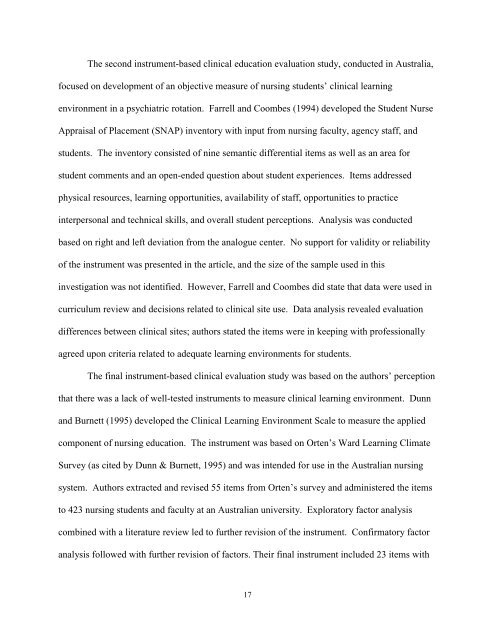STUDENT EVALUATION OF CLINICAL EDUCATION ENVIRONMENT
STUDENT EVALUATION OF CLINICAL EDUCATION ENVIRONMENT
STUDENT EVALUATION OF CLINICAL EDUCATION ENVIRONMENT
You also want an ePaper? Increase the reach of your titles
YUMPU automatically turns print PDFs into web optimized ePapers that Google loves.
The second instrument-based clinical education evaluation study, conducted in Australia,<br />
focused on development of an objective measure of nursing students’ clinical learning<br />
environment in a psychiatric rotation. Farrell and Coombes (1994) developed the Student Nurse<br />
Appraisal of Placement (SNAP) inventory with input from nursing faculty, agency staff, and<br />
students. The inventory consisted of nine semantic differential items as well as an area for<br />
student comments and an open-ended question about student experiences. Items addressed<br />
physical resources, learning opportunities, availability of staff, opportunities to practice<br />
interpersonal and technical skills, and overall student perceptions. Analysis was conducted<br />
based on right and left deviation from the analogue center. No support for validity or reliability<br />
of the instrument was presented in the article, and the size of the sample used in this<br />
investigation was not identified. However, Farrell and Coombes did state that data were used in<br />
curriculum review and decisions related to clinical site use. Data analysis revealed evaluation<br />
differences between clinical sites; authors stated the items were in keeping with professionally<br />
agreed upon criteria related to adequate learning environments for students.<br />
The final instrument-based clinical evaluation study was based on the authors’ perception<br />
that there was a lack of well-tested instruments to measure clinical learning environment. Dunn<br />
and Burnett (1995) developed the Clinical Learning Environment Scale to measure the applied<br />
component of nursing education. The instrument was based on Orten’s Ward Learning Climate<br />
Survey (as cited by Dunn & Burnett, 1995) and was intended for use in the Australian nursing<br />
system. Authors extracted and revised 55 items from Orten’s survey and administered the items<br />
to 423 nursing students and faculty at an Australian university. Exploratory factor analysis<br />
combined with a literature review led to further revision of the instrument. Confirmatory factor<br />
analysis followed with further revision of factors. Their final instrument included 23 items with<br />
17












